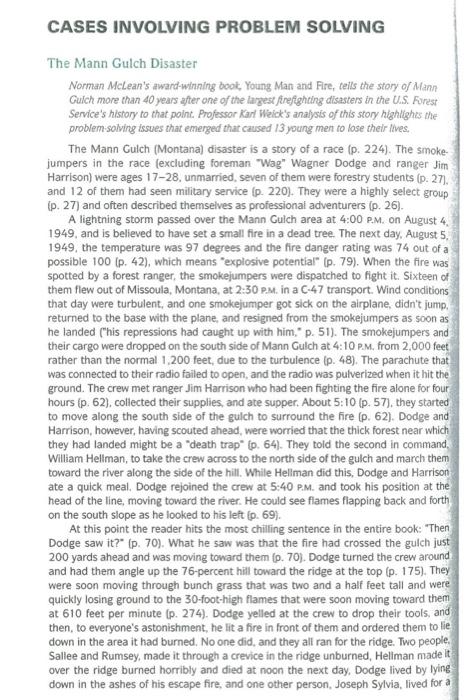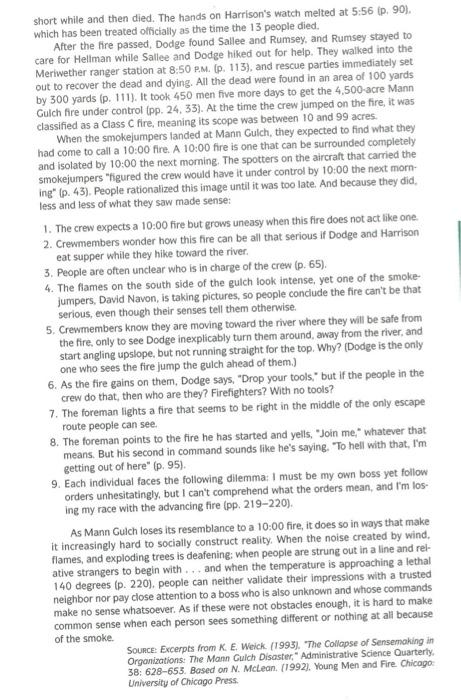The Mann Gulch Disaster Norman Mctean's award-winning book, Young Man and Fire, tells the story of Mann Gulch more than 40 years after one of the largest finefighting disasters in the ULS. Fvesst Service's history to that polnt. Professor Kanl Weick's analysis of this story hightights the problemsolving issues that emerged that caused 13 young men to lose thel twes. The Mann Gulch (Montana) disaster is a story of a race (p,224). The smokejumpers in the race (excluding foreman "Wag" Wagner Dodge and ranger Jim Harrison) were ages 17-28, unmarried, seven of them were forestry students (p. 27). and 12 of them had seen military service (p. 220). They were a highly select group (p. 27) and often described themselves as professional adventurers (p. 26). A lightning storm passed over the Mann Gulch area at 4:00 P.M. on August 4, 1949, and is believed to have set a small fire in a dead tree. The next day. August 5 , 1949, the temperature was 97 degrees and the fire danger rating was 74 out of a possible 100 (p. 42), which means "explosive potential" (p. 79). When the fire was spotted by a forest ranger, the smokejumpers were dispatched to fight it. Sixteen of them flew out of Missoula, Montana, at 2:30 PM. in a C-47 transport. Wind conditions that day were turbulent, and one smokejumper got sick on the airplane, didn't jump. returned to the base with the plane, and resigned from the smokejumpers as soon as he landed ("his repressions had caught up with him, " p. 51). The smokejumpers and their cargo were dropped on the south side of Mann Gulch at 4:10 P.M. from 2,000 feet rather than the normal 1,200 feet, due to the turbulence (p. 48). The parachute that was connected to their radio failed to open, and the radio was pulverized when it hit the ground. The crew met ranger Jim Harrison who had been fighting the fire alone for four hours (p, 62), collected their supplies, and ate supper. About 5:10 (p. 57), they started to move along the south side of the gulch to surround the fire [p,62]. Dodge and Harrison, however, having scouted ahead, were worried that the thick forest near which they had landed might be a "death trap" (p. 64). They told the second in command. William Hellman, to take the crew across to the north side of the gulch and march them toward the river along the side of the hill. While Hellman did this, Dodge and Harrison ate a quick meal. Dodge rejoined the crew at 5:40 P.M. and took his position at the head of the line, moving toward the river. He could see flames flapping back and forth on the south slope as he looked to his left (p. 69). At this point the reader hits the most chiling sentence in the entire book: "Then Dodge saw it?* (p. 70). What he saw was that the fire had crossed the gulch just 200 yards ahead and was moving toward them (.70). Dodge turned the crew around and had them angle up the 76-percent hill toward the ridge at the top ( p. 175). They were soon moving through bunch grass that was two and a half feet tall and were quickly losing ground to the 30 -foot-high flames that were soon moving toward them at 610 feet per minute (p. 274). Dodge yelled at the crew to drop their tools, and then, to everyone's astonishment, he lit a fire in front of them and ordered them to fie down in the area it had burned. No one did, and they all ran for the ridge. Two people. Sallee and Rumsey, made it through a crevice in the ridge unburned, Heliman made it over the ridge burned horribly and died at noon the next day, Dodge lived by lying down in the ashes of his escape fire, and one other person, Joseph Sylvia, lived for a short while and then died. The hands on Harrison's watch melted at 5:56(p,90). which has been treated olficially as the time the 13 people died. After the fire passed, Dodge found Sallee and Rumsey, and Rumsey stayed to care for Heliman while Sallee and Dodge hiked out for help. They walked into the Meriwether ranger station at 8:50 P.M. (p,113), and rescue parties immediately set. out to recover the dead and dying. All the dead were found in an area of 100 yards by 300 yards (p.111). It took 450 men five more days to get the 4,500 -acre Mann Gulch fire under control (pp, 24,33). At the time the crew jumped on the fire, it was classified as a Class C fire, meaning its scope was between 10 and 99 acres. When the smokejumpers landed at Mann Gulch, they expected to find what they had come to call a 10:00 fire. A 10:00 fire is one that can be surrounded completely and isolated by 10:00 the next moming. The spotters on the aircraft that carried the smokejumpers "figured the crew would have it under control by 10:00 the next morning" (p. 43). People rationalized this image until it was too late. And because they did. less and less of what they saw made sense: 1. The crew expects a 10:00 fire but grows uneasy when this fire does not act like one. 2. Crewmembers wonder how this fire can be all that serious if Dodge and Harrison eat supper while they hike toward the river. 3. People are often unclear who is in charge of the crew (p. 65). 4. The flames on the south side of the gulch look intense, yet one of the smokejumpers, David Navon, is taking pictures, so people condude the fire can't be that serious, even though their senses tell them otherwise. 5. Crewmembers know they are moving toward the river where they will be safe from the fire, only to see Dodge inexplicably turn them around, away from the river, and start angling upstope, but not running straight for the top. Why? (Dodge is the only one who sees the fire jump the gulch ahead of them.) 6. As the fire gains on them, Dodge says, "Drop your tools, but if the people in the crew do that, then who are they? Firefighters? With no tools? 7. The foreman lights a fire that seems to be right in the middle of the only escape route people can see. 8. The foreman points to the fire he has started and yells, "Join me," whatever that means. But his second in command sounds like he's saying. "To hell with that, I'm getting out of here" (p,95). 9. Each individual faces the following dilemma: I must be my own boss yet follow orders unhesitatingly, but 1 can't comprehend what the orders mean, and I'm losing my race with the advancing fire (pp, 219-220). As Mann Gulch loses its resemblance to a 10:00 fire, it does so in ways that make it increasingly hard to socially construct reality. When the noise created by wind. flames, and exploding trees is deafening; when people are strung out in a line and relative strangers to begin with .... and when the temperature is approaching a lethal 140 degrees (p. 220), people can neither validate their impressions with a trusted neighbor nor pay close attention to a boss who is also unknown and whose commands make no sense whatsoever. As if these were not obstacles enough, it is hard to make common sense when each person sees something different or nothing at all because of the smoke. Sounce: Excerpts from K. E. Weick. (1993), "The Collopse of Sensemaking in Orgonizationst The Mann Gulch Disaster, Administrative Science Quarterly, 38:628-653, Bosed on N. McLean. (1992). Young Men and Fire ChicagoUniversity of Chicago Press. Discussion Questions 1.What conceptual blocks were experienced by the smokejumpers? (2) What steps in analytical problem solving were skipped or short-circuited by the fire crew? (3.)How do problem-solving and decision-making processes change under time pressures or crises









